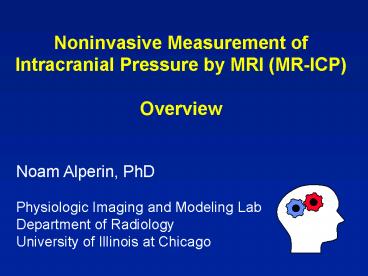Noninvasive Measurement of Intracranial Pressure by MRI MRICP Overview - PowerPoint PPT Presentation
1 / 25
Title:
Noninvasive Measurement of Intracranial Pressure by MRI MRICP Overview
Description:
Physiologic Imaging and Modeling Lab Department of Radiology. University of Illinois at Chicago ... dP are measured by MR imaging of blood and CSF flow2. The ... – PowerPoint PPT presentation
Number of Views:665
Avg rating:3.0/5.0
Title: Noninvasive Measurement of Intracranial Pressure by MRI MRICP Overview
1
Noninvasive Measurement of Intracranial Pressure
by MRI (MR-ICP)Overview
Noam Alperin, PhD Physiologic Imaging and
Modeling Lab Department of Radiology University
of Illinois at Chicago
2
Importance
Normal brain function requires regulation of
cerebral blood flow (CBF) and intracranial
pressure (ICP). In many neurological problems
this regulation is disrupted. Our lab is
developing noninvasive method to quantify these
important physiological parameters by MRI. The
method could potentially become an important
diagnostic test for over million patients
annually in the US alone, who suffer from related
neurological problems (e.g., strokes,
intracranial hemorrhages head injuries,
hydrocephalus, Chiari malformations, etc)
3
ICP Measurement by MRI
Monitoring
Diagnostic test
The MRI-based method (MR-ICP) integrates
knowledge from human neuro-physiology, principles
of fluid dynamics, and dynamic MRI to
non-invasively measure ICP. These are briefly
described in the following slides.
4
Blood and CSF Flows through the Craniospinal
Compartments
The pulsatile cerebral blood flow drives the
cerebrospinal fluid (CSF) flow. During systole,
arterial inflow exceeds venous outflow, which
result in CSF outflow1. Intracranial compliance
and pressure are calculated from measurements of
these flows.
1. Alperin et al, Magn Reson, in Med. 1996
5
The Neurophysiology Basis
Intracranial Pressure-Volume Curve
Intracranial pressure and volume are
exponentially related. Thus, at low ICP, a
small increase in volume (dV) will cause a small
increase in pressure (dP). At high ICP, the same
small volume increase (dV) will cause a large
increase in pressure (dP). The ratio of dP/dV
(elastance) is a linear function of ICP. MR-ICP
measures dP and dV using CSF and blood volumetric
flow rate measurements.
Elastance dP/dV
6
The Principles of MR-ICP
- MR-ICP is the noninvasive analogous of the bolus
pressure-volume infusion test (Marmarou 1978) - Pulsatile cerebral blood flow causes a momentary
increase in intracranial volume (dV) during
systole - dV causes the pulse pressure (dP)
- dV/dP is intracranial compliance
- The inverse of compliance is a linear function of
mean ICP. - dV and dP are measured by MR imaging of blood
and CSF flow2
2. Alperin et. al. Radiology. 2000 217 (3)
877885.
7
How is dV Measured?
The systolic increase in intracranial volume
(ICV) during each cardiac cycle is derived from
momentary difference between volumes of blood,
and CSF that entering and leaving the cranium
during the cardiac cycle
Arterial blood in
Venous blood out
ICV
CSF out and in
8
How is Volumetric Blood Flow Measured?
Phase contrast MRI scan with high velocity
encoding provides velocity images from which
blood flow to and from the cranium is calculated.
Velocity image
9
Blood Flow Dynamics
10
Volumetric Blood Flow Measurement
Vertebral art.
Jugular v.
Int. Carotid art.
Volumetric Flow Velocity X Lumen area
Lumen area is identified automatically using the
Pulsatility Based Segmentation (PUBS) Method 3
3. Alperin N, Lee S. Magn. Reson. in Med.
49934944 (2003)
11
Volumetric Arterial Inflow and Venous Outflow (in
mL/min)
One cardiac cycle
Total CBF is the cycle-averaged arterial inflow
12
How is CSF Flow Measured?
Phase contrast MRI scan with low velocity
encoding provides images of CSF velocities from
which CSF flow to and from the cranium is
calculated.
Velocity images
Systole
Diastole
13
Cervical CSF and Epidural Venous Flow Dynamics
14
CSF Volumetric Flow
One cardiac cycle
15
Calculating Systolic ICV Change (DICV)
ICV
DICV waveform
A - V CSF
?dt
16
The MR-ICP Provides a Patients Specific
Cranio-Spinal Flow Dynamics
17
How is dP Measured?
- The pressure change during the cardiac cycle is
derived from CSF pressure gradient (? p), i.e.,
the pressure difference that causes the CSF to
flow out from and back into the cranium.4 - The Navier-Stokes equation is used to calculate
CSF pressure gradients from the CSF velocities.
???? dv/dt v???? v????-??????v ????- ? p
inertial force
viscous losses
4 Loth FM, Yardimici MA, Alperin N. Jour. of
Biomechanical Engineering. 2001, Vol. 123, pp.
71-79.
18
CSF Pressure Gradient Waveform
SD of PTP is lt7
19
Invasive ICP Recording and Corresponding MRI
Derived Pressure Gradients in Humans
Elevated ICP
Low ICP
red viscous term
20
Validation of dP Measurement
Validations were done with large nonhuman
primates because fluid dynamics principles are
scale-dependent.
0.012
0.01
0.008
0.006
Pressure gradient (mmHg/cm)
0.004
0.002
0
0
2
4
6
8
10
PTP Pressure (mmHg)
)
Human
Baboon
21
Initial Validation of MR-ICP in Humans
The MR-ICP method was validated in patients with
SAH who had an EVD at the time of their MRI scan.
Alperin et. al. Radiology. 2000 217 (3)
877885.
22
What is Normal MR-ICP ?
MR-ICP in Healthy Subjects (71 measurements in
23 subjects)
Invasive
Mean 9.6 mmHg 31 Range 3.5 to 17.1 mmHg
23
Reduction to Practice
Total MRI scan time with the current technique is
approximately 3 minutes. A software tool is
being developed to facilitate quantitation of the
blood and CSF volumetric flow rates, from which
total CBF, compliance, and ICP are determined
within few minutes.
24
The automated lumen segmentation tool is based on
the PUBS technique.3
3. Alperin N, Lee S. Magn. Reson. in Med. (2003)
25
Physiologic Imaging and Modeling Lab, Dept. of
Radiology University of Illinois at Chicago
Current and previous lab members who contributed
to this work
- Noam Alperin, PhD
- Aaron Lee, MS
- Naresh Yallapragada, MS
- Hasan Dhoondia, MS
- Anusha Sivaramakrishnana
RSNA 2003
- Collaborators
- Terry Lichtor, MD, PhD - Neurosurgery, Cook
County - Roberta Glick, MD - Neurosurgery, Cook
County - Francis Loth, PhD - Mechanical Eng., Uni. of
Illinois































